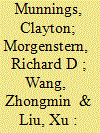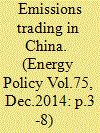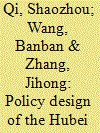|
|
|
Sort Order |
|
|
|
Items / Page
|
|
|
|
|
|
|
| Srl | Item |
| 1 |
ID:
150004


|
|
|
|
|
| Summary/Abstract |
To help overcome the challenge of growing CO2 emissions, China is experimenting with market-based instruments, including pilot CO2 emissions trading systems (ETSs) in seven regions that serve as precursors of a national CO2 ETS. Implementing an ETS in a rapidly growing economy in which government authorities exercise significant control over markets poses many challenges. This study assesses how well three of the most developed pilot ETSs, in Guangdong, Shanghai, and Shenzhen, have adapted carbon emissions trading to China's economic and political context. We base our study on new information gathered through interviews with local pilot ETS regulators and experts, analysis of recent trading data, and extensive legal and literature reviews. We point out instances in which pilot regulators have deftly tailored carbon emissions trading to China's unique context and instances in which designs are insufficient to ensure smooth operation. We also indicate areas in which broader institutional reforms of China's political economy may be required for carbon emissions trading to operate successfully. We make nine recommendations to improve the design and operation of the pilot programs and to inform the construction of a national CO2 ETS.
|
|
|
|
|
|
|
|
|
|
|
|
|
|
|
|
| 2 |
ID:
136186


|
|
|
|
|
| Summary/Abstract |
China has implemented emissions trading schemes in seven cities and provinces, and is planning a national cap-and-trade scheme. The seven pilot schemes show marked differences in design and operate in very diverse economic circumstances. Challenges encountered in the pilot schemes include the risk of over-allocation of emissions permits, unpredictable underlying growth trends, robust measurement and verification procedures, and the interaction with regulation in the energy sector. In addition, experiences from developed countries’ emissions trading schemes, in particular the EU ETS, can help inform the decisions about the design of a future Chinese national scheme. We find that Chinese policymakers will need to pay particular attention to the operation of emissions trading in a heavily regulated electricity sector. Setting emission caps in the context of a national emissions intensity target creates specific difficulties. Related price developments are uncertain and depend largely on underlying emissions growth rates. The option of auctioning permits and using the proceeds for other purposes is not taken into consideration extensively. Finally, implementing reliable systems for monitoring, reporting and verification of emissions remains a major task. This paper serves as an introduction to the special issue “Emissions trading in China” and draws on insights from the papers in the special issue.
|
|
|
|
|
|
|
|
|
|
|
|
|
|
|
|
| 3 |
ID:
136190


|
|
|
|
|
| Summary/Abstract |
Of seven pilot emissions trading schemes (ETS) being run in China, the ETS in Hubei province is the only provincial pilot in the central and western regions of the country with a high GDP growth rate and heavy industrial structure. As such, it is quite representative of China as a whole and its ETS will therefore be reasonably characteristic of a future nationwide market. This paper describes the policy design of the Hubei ETS, including aspects of coverage, cap, allowance allocation, transactions, compliance and penalties. Then, after making a comparison with the other Chinese pilots and emissions trading schemes in the European Union (EU) and California, the paper offers a summary of several distinct features of the Hubei ETS. First, the small numbers of entities that are covered by the scheme produce a considerable proportion of the emissions. This makes Hubei the world׳s third largest carbon market. Second, the Hubei ETS applies several mechanisms to deal with the province’s rapid growth rate. Third, the scheme׳s policy design emphasizes liquidity. In addition to these unique features, the Hubei ETS also shares some common features with all the pilots in China.
|
|
|
|
|
|
|
|
|
|
|
|
|
|
|
|
|
|
|
|
|